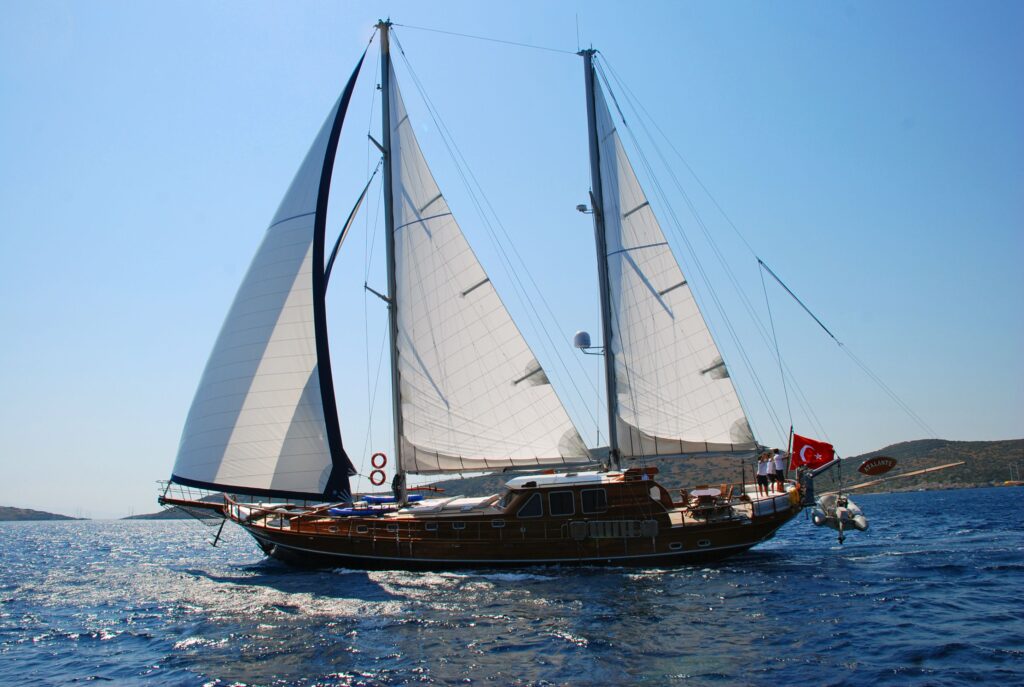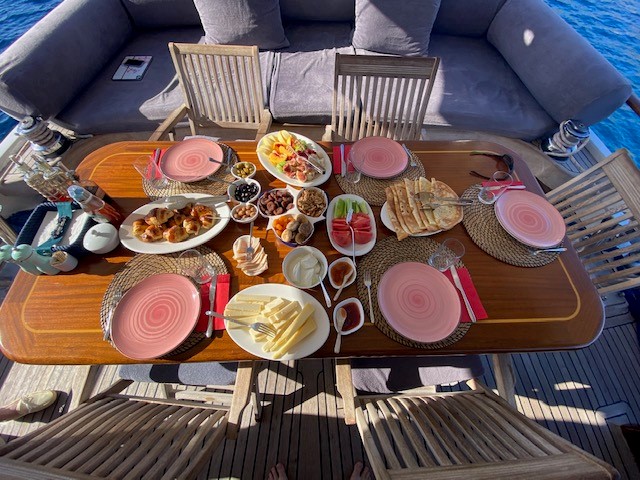By David Barclay | November 15, 2023

I’ve recently had several inquiries from both current and prospective clients regarding chartering boats for upcoming vacations. Given the uptick in interest in this form of travel, I decided to focus today’s blog post on the world of private boat and yacht charters. You may think the realm of private charters is only for movie stars, professional athletes, and the super-wealthy. And I’ll admit, there are plenty of mega yachts available for charter that can cost hundreds of thousands of dollars per week. But the world of chartering isn’t restricted to just yachts, and there are plenty of mid-sized boats available for charter that compare in cost to a moderate luxury vacation. In fact, in many cases the experience on a private crewed boat, which tailors the sailing itinerary to the guests’ specific interests, can deliver a better vacation experience (and sometimes at a lower cost) than a land vacation.
Chartering a private boat may seem complex, with hundreds of boats listed for charter in each popular sailing region of the world. But in reality the process is fairly straightforward and not much different from selecting a beachside resort or a luxury cruise itinerary. The key is to have a good advisor with access to boats that have been thoroughly vetted, to ensure you are getting a boat in pristine condition with a knowledgeable and skilled crew.
Below I’ve provided a high level guide on chartering a private boat, divided into four sections. First, the types of boats available for charter, ranging from mid-sized sailboats and catamarans up to the mega yachts that grab all of the attention. Next, the types of charters and what is included in the base charter fee. I’ve also provided a brief overview of some of the most popular charter regions and what you can see & do in each location. Last I’ve provided a high level overview of the chartering process and how to locate the perfect boat. If you think a private charter might be a good option for one of your future vacations, let’s set up some time to discuss in more detail.
Types of Boats

While this is not an exhaustive list of boat/ship types, it encompasses 90%+ of the boats available for charter.
Monohull Sailboats
Monohull sailboats have one large hull and one or more masts. Boat lengths start at around 50′, with length and beam growing as guest capacity increases. These boats will have between 3-6 cabins and can accommodate 2-12 guests. Monohulls have less interior and exterior space when compared to the other charter options (given the same boat length), but monohulls can also be the most economical option for chartering. Charter rates start at around $2,500/pp for a week charter.
Gulets
Gulets are a special type of hand built wooden monohull sailboats. They are very popular in Turkey, Croatia, and Greece. They tend to have greater beams and drafts when compared to other monohull designs, providing more room for guests. The tradeoff for this extra space is that gulets sit lower in the water and require stronger winds to sail. For this reason, many gulets travel only under power. If you are interested in chartering a gulet but want to ensure you can travel under sail power, you should mention this upfront, so a gulet designed for sailing is selected for your charter. Gulets will have between 3-6 cabins and typically accommodate 6-12 guests, but in some regions larger gulets are available, making them a good option for larger travel groups and multi-generational family vacations. Charter rates start at around €3,000/pp per week for a standard gulet. Luxury gulets, which add more space and amenities, start around €5,000/pp/wk. For more details, see my blog post on Chartering a Turkish Gulet.
Sail Catamarans
Probably the most common boat type available for charter, sail catamarans are available in many of the most popular charting regions. Catamarans have two hulls which are connected by a large superstructure. The design of a catamaran provides a large amount of interior and exterior space for a given boat length, one of the reasons for their popularity. They are also more stable than monohulls, both under sail and at anchor. The shallow drafts of modern catamarans mean they can cruise under sail power most of the time and anchor close to shore. Catamarans also provide easy water access, with stairs on the aft of each hull leading right to the waterline. Newer catamarans will also have a “fly bridge” above the main deck, adding extra outdoor space and stunning 360-degree panoramic views. Catamarans start at 45′ in length, have 2-6 cabins and can accommodate 2-12 guests. Sail catamarans generally cost a little more to charter than monohulls, but the added space and stability justify the investment in a catamaran charter. Charter rates start at around $3,200/pp per week.
Power Catamarans
Power catamarans resemble sailing catamarans in that they also have two hulls connected with a superstructure in the middle. And just like their sail siblings, this design provides more width and deck space, as well as added stability, when compared to a power monohull of similar length. Because they don’t have sails, they use motors to travel, but this allows them to travel at higher speeds and cover greater distances than is possible for a sail catamaran. Most power catamarans are 60-70’ in length, have 3-5 cabins and accommodate 6 to 10 guests. Charter rates start at around $4,000/pp per week.
Luxury Motor Yachts
Motor yachts are popular for the onboard space they provide and the distances they can cover in a typical week charter. This is the biggest category for boat charters in terms of options. Motor yachts can range in size from 50′ all the way up to several hundred feet in length. Yachts under 80′ will typically have 3 decks and as yacht size increases, they add more decks and additional amenities. They will have between 3-6 cabins and accommodate 6-12 guests. While larger yachts add more space, international regulations typically limit the number of guests allowed to a maximum of 12 (though some options exist for higher guest capacity). There is no limit on the crew compliment, so as the yacht size increases, so does the size of the crew and its ability to pamper guests. The charter rates for luxury motor yachts vary as widely as the boats themselves, rates can range from $8,000/pp to $50,000+/pp plus expenses per week.
Types of Charters

Bareboat, Skippered, & Crewed
While I would not recommend either of the first two options for my clients, if you do any research on charting you will come across these terms, so I wanted to quickly explain them. Bareboat means you are just chartering the boat and must be a licensed skipper to do so. Skippered means you are chartering the boat with a skipper, but no other crew (the skipper sails the boat, but won’t cook, serve drinks, etc.). A crewed charter means you have a crew of 2+ to take care of you on your vacation. With two crew members, you will typically have a captain and a chef/first mate. The captain will sail the boat, drive the tender, etc. while the chef/first mate takes care of meals and sees to the guests’ needs while on board. Larger boats will add deck hands and stewards to see to the running of the boat and the needs of the guests.
All-Inclusive Charters
Most sailing boats in the Caribbean as well as some smaller motor yachts operate under these terms. The charter rate includes the hire of the yacht and crew, all meals, snacks, open bar (champagnes, vintage wines, extraordinary brands, and excessive consumption are additional), the use and instruction of all onboard watersports equipment, cruising taxes, and port fees. Generally, the only additional cost is for ground transfers, shoreside activities, and the crew gratuity (recommended 10-20% of the base charter, but dependent on the region sailed). Many sailing yachts in the lower Caribbean (from St. Maarten to Grenada) use a variation where everything except the bar is included, and beverages are charged to guests “at cost”. In Turkey, many gulets include everything except for meals & beverages. Guests can pay a per diem for meals (see half and full board below) which includes non-alcoholic beverages and guests can bring their own alcohol on board which the crew will serve.
Plus Expenses
The charter rate includes the hire of the yacht, the crew, and the yacht’s insurance. Guests pay for all operating expenses of the yacht “at cost”. These expenses include the food and beverage for the guests, fuel for the yacht/tenders/water toys, port fees, cruising taxes, etc. Typically, these additional costs add approximately 30-40% to the yacht charter rate on a motor yacht and about 20-25% on a sailing yacht. The charterer will be asked to pay an Advanced Provisioning Allowance (APA) with the final charter payment. During the charter, the captain will account for all expenses and will present the charterer with a detailed statement. Any unused APA monies are refunded to the charterer at the end of the charter. Conversely, any shortfall will be payable by the charterer before disembarking.
Full Board & Half Board
Most all-inclusive charter rates include full board, which means all meals for the duration of the charter are provided. Most boats will offer a discount if guests opt for a half board option, which means 7 breakfasts, 4 lunches & 3 dinners eaten on board, all other meals must be eaten ashore at the guests’ expense. For many gulet charters, guests can add either half board or full board options for meals. Plus Expenses charters may offer these options, or may allow guests to select which meals they will eat on board, the only caveat is that guests need to decide in advance of the charter so the crew is able to acquire the correct amount of provisions.
Where to Charter

This is not an exhaustive list of locations with charter options, but a highlight of the most popular destinations.
Virgin Islands (U.S. Virgin Islands & BVIs)
The most popular destination for guests from the U.S. is the Virgin Islands. They are also a great option for first-time charterers. The Virgin Islands proximity to the U.S. makes getting to them relatively easy, the islands are close together so sailing distances are short, and the waters are protected and relatively calm. There are many boats of all types available for charter, making finding the perfect boat relatively straightforward. Charters begin from either St. Thomas or Tortola and the best time to visit is between November and July (outside of peak hurricane season). Guests can spend their time enjoying the Caribbean weather, swimming in the clear waters, and exploring the islands at a casual and relaxed pace.
Leeward & Windward Islands
A more cosmopolitan and authentic Caribbean experience and one that may appeal to those who have already visited the Virgin Islands. The islands are less sheltered so the sailing experience can be more robust, and the distances are greater, favoring a powered catamaran or yacht to ensure guests can move around quickly.
Bahamas
Guests can fly into Nassau and then sail around the Exuma islands. The islands are more off the beaten path and there is less to do onshore, so this region is good for guests who want more of a boating experience and lots of time spent on the water. Sport finish, diving, and water sports are popular activities. The best time to charter is April – December.
Greece
Greece is a popular destination during the spring, summer and fall months. Greece provides a lot of history with the ability to explore ancient ruins. While guests may want to visit Mikonos or Santorini, these ports tend to get overcrowded and with a private charter guests can easily visit other smaller Greek ports and avoid the crowds. Sailing charters will be more restricted in where they can visit given the distances involved and all charter guests will want to pay attention to the Meltemi Winds, which can create rougher seas and result in captains needed to alter the itinerary (which means no port visit can be guaranteed while the Meltemi are blowing in the summer). Low season is June & September, when prices are lower and seaside towns less crowded.
Croatia
Charters in Croatia will sail the Dalmatian Coast between Dubrovnik and Split. This is one of the best Mediterranean sailing regions for first time charterers as the waters are sheltered and the islands are close together, reducing sailing distances. Croatia is also good for larger travel groups, it is one of the few regions that does not restrict guest capacity to a max of 12. Guests can combine time on the water with shore visits to both quaint seaside towns and larger cities like Hvar.
Turkey
The southwestern shoreline of Turkey is another great destination for first time charterers. The waters are as sheltered and protected as the BVIs and Dalmatian Coast, but provide a more exotic experience than those other popular regions. By far the most popular boat to charter is the gulet. Guests can sail between Bodrum and Gocek, visiting seaside towns and exploring ancient ruins (there are more Greek ruins in Turkey than in Greece). Many sheltered coves nestled into the islands provide good locations to swim during the day and anchor at night.
The Chartering Process

The first step is to decide when and potentially where you’d like to charter a boat. After a quick discussion to gather critical information such as the type of boat desired, number of guests (and ages), and any special needs/requirements, a short list of recommended boats will be assembled. We try to not only match the boats’ features and amenities but also the crews with each traveling group. Families will appreciate a crew that enjoys children and wants to help them explore the natural surroundings or teach them how to water ski. Foodies will appreciate a skilled chef who can prepare extravagant meals.
After selecting the boat and confirming availability, we can place a two week hold on the desired charter dates while finalizing the charter. We will draw up the charter contract, specifying the terms of the charter including what’s included in the charter rate and any equipment the boat guarantees for the charter period. The lead charterer will need to sign the contract and pay a deposit (25-50% of charter rate) to confirm the charter.
Once the charter is confirmed, we will provide the lead charterer with a Charter Questionnaire. The questionnaire is used to gather information about all of the guests, food preferences, activity preferences, and to indicate anything else the guests desire for the charter. This information is provided to the crew so they can prepare the boat for the charter group.
If a 25% deposit was collected at the charter confirmation, an interim deposit of 25% will be required 6 months prior to the start of the charter. The final payment of 50% will be due 45-60 days prior to the start of the charter.
For Caribbean charters, the crew will typically reach out to the guests about 2 weeks prior to arrival to confirm the details of the charter, ask about any last-minute requests and assist with transfers to the boat (if needed). Given the time zone difference, for Mediterranean charters the crew is more likely to work through the travel advisor for any last-minute updates prior to guests departing for their vacation.

David Barclay
Owner, Barclay & Company Travel
Thanks for visiting the Barclay & Company Travel blog! If you’re new here, check out Our Story, learn about the Value we provide, or Contact Us to start planning your next adventure.
Check back often for new posts and if you haven’t already, please subscribe to our newsletter!